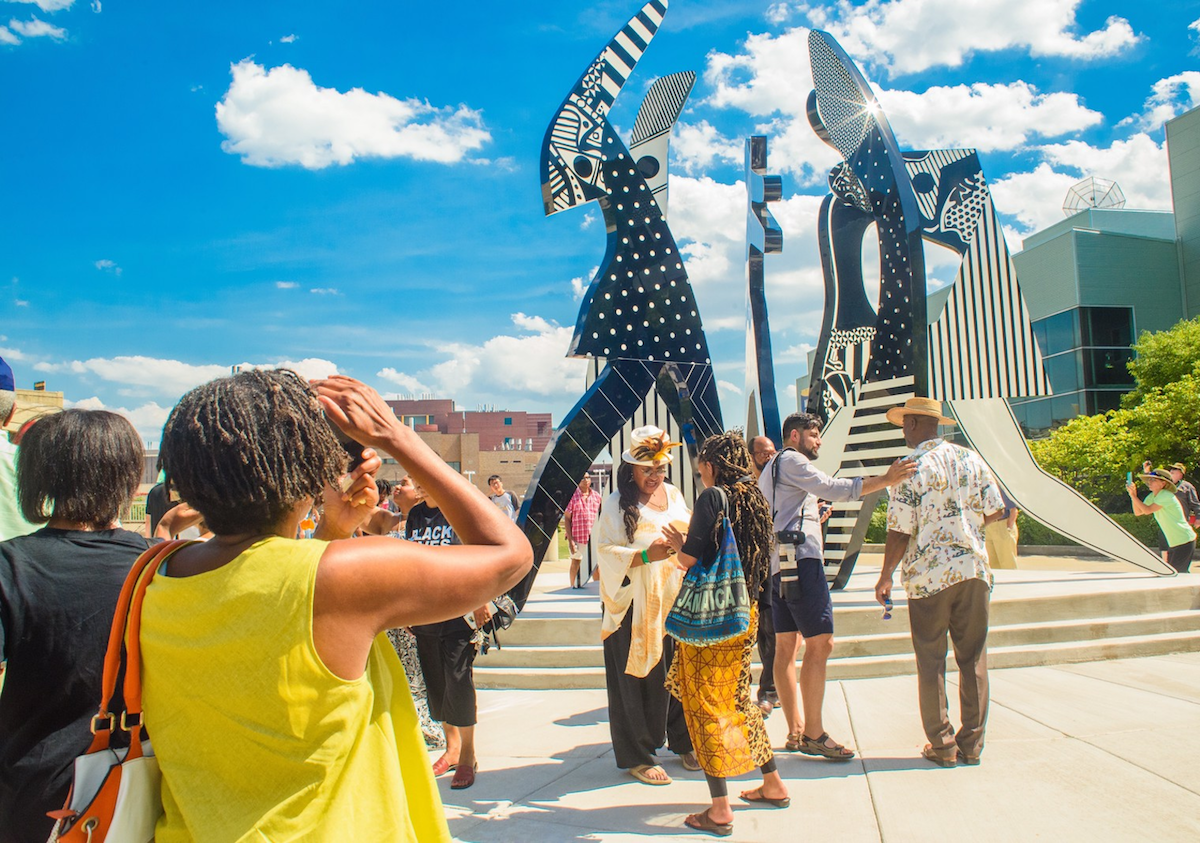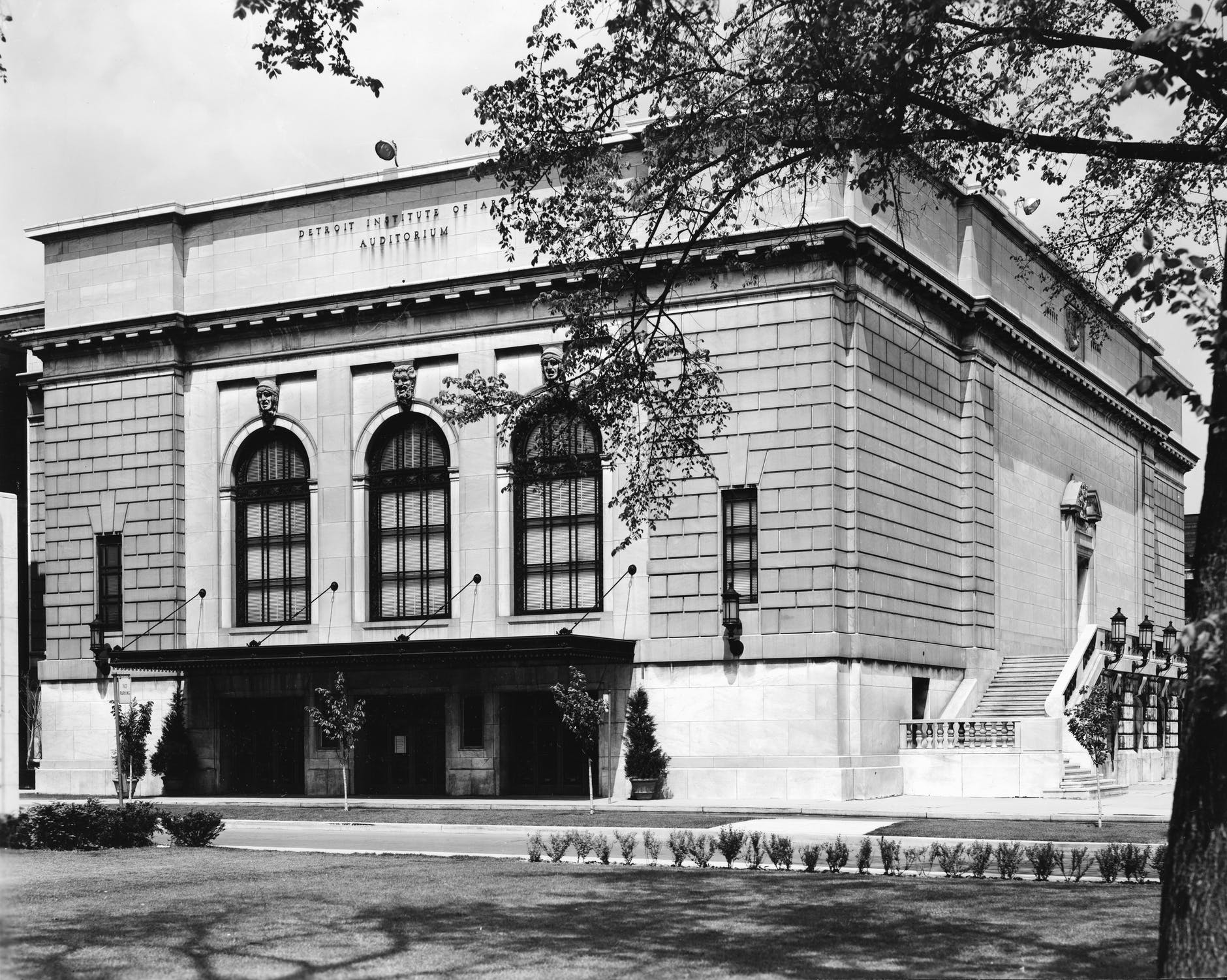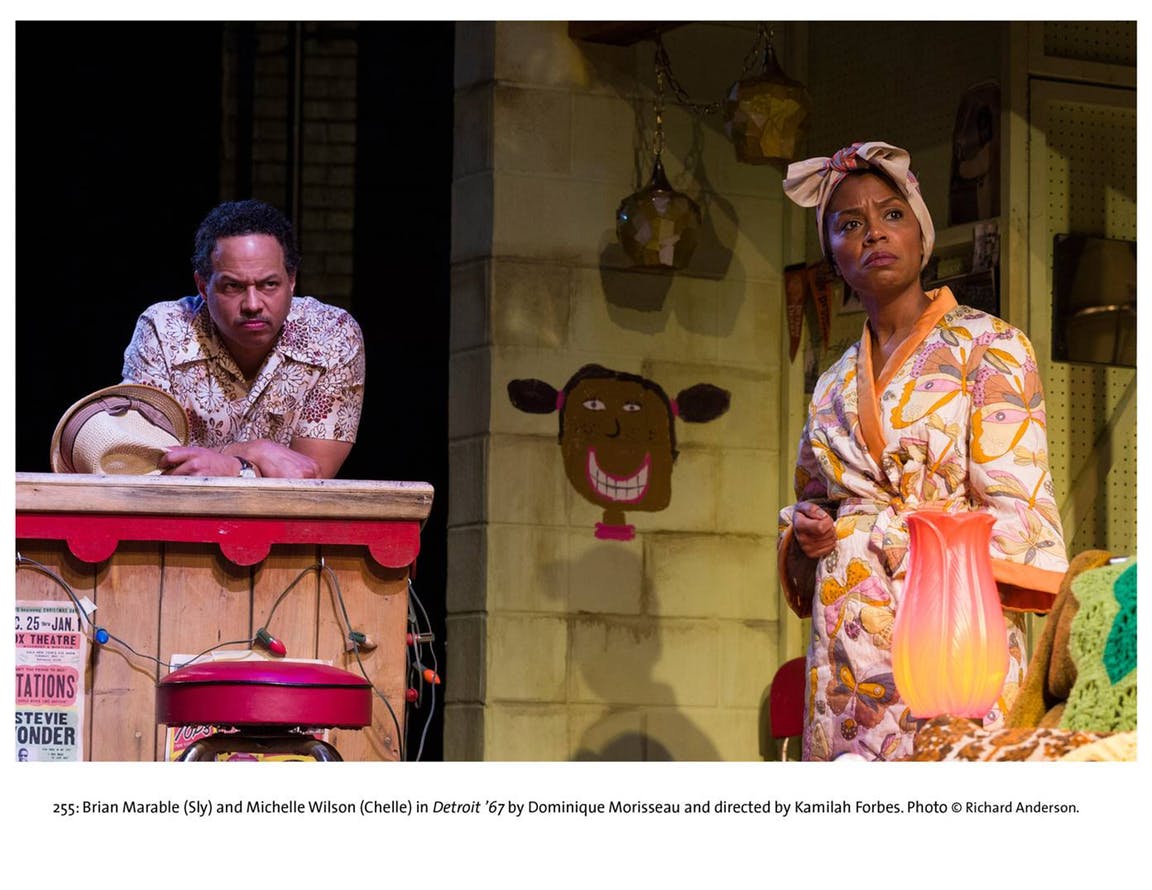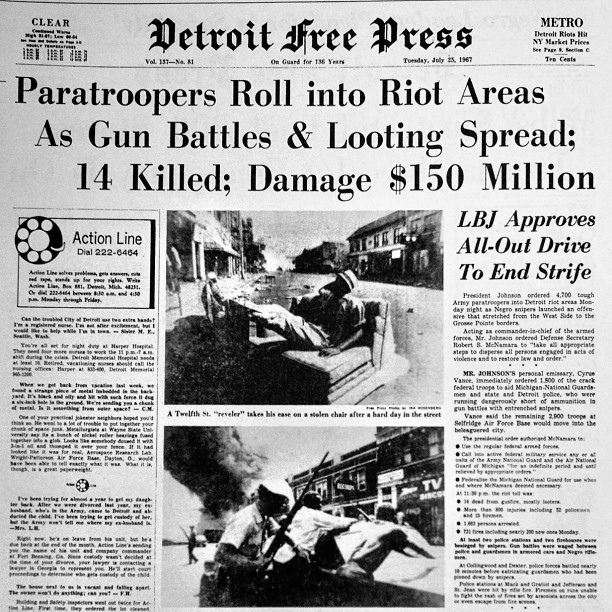
Arts groups help Detroit explore how the summer of 67 changed the city forever
Detroit.
July 23, 1967.
Twelfth Street and Clairmount.
3:15 a.m.
Police raid a speakeasy.
An uprising breaks out.
Rioting. Looting. Anger. Frustration. Fear.
Forty-three dead; 1,189 injured.
Five days.
A city forever changed.
Changed in the way you’ve heard – accelerated flight from the city, abandonment by a generation of Detroiters – but also in ways you may not. That night indelibly marked Detroit’s future as the city’s narrative cleaved in half.
For some, a riot occurred. “Black power militants promoting a revolution,” as one man told the Detroit Historical Society in an oral history collected for the “Detroit 67: Looking Back to Move Forward” exhibit.
For others, it was a rebellion. A last straw after decades of unequal treatment, police brutality, housing discrimination and more.
Or is it the more neutral “civil unrest” or “uprising”?
Fifty years since that night and Detroit is still grappling with the power of language. What to call it? Whether you see those four days in July as riot or rebellion is defined by the color of your skin and where you were standing. What was your vantage point? Who are you related to and where were they watching from?
“The 1967 riot, or rebellion, as many blacks preferred to call it, was the result of decades of white institutionalized racism,” writes Joe T. Darden and Richard W. Thomas, in their book “Detroit: Race Riots, Racial Conflicts, and Efforts to Bridge the Racial Divide. “Few whites were willing or able to connect the historical and social causes to their tragic consequences. Most blacks had no trouble doing so.”

For Ron Fournier, who grew up on Detroit’s east side, it was a riot. But as the editor and publisher of Crain’s Detroit Business, he recently wrote a column exploring the language.
“I call what happened in Detroit in 1967 a riot because my father called it a riot, and my father called it a riot because he was a Detroit riot cop,” he wrote.
But for activist and journalist Frank Joyce, it was a rebellion. And the debate is “part of the summer ritual here,” he says in his oral history for the Detroit Historical Society. “I say that to say that the ‘riot’ versus ‘rebellion’ debate, it’s like a smoldering ember and the flames shoot up all over again.”
As the 50th anniversary of the civil unrest approaches, nearly a dozen Detroit-area cultural organizations are stoking those embers. They are creating programming that asks people to think about what happened, what they call it and how the events impacted the past – and the future – of the region. Along the way, the conversations are probing the city’s history, and its sense of self, on a deeper level that often only art and cultural institutions can reach.
Some large-scale projects have recently debuted, such as “12th and Clairmount,” a documentary film produced by the Detroit Free Press in conjunction with Bridge Magazine and WXYZ (Channel 7). Many other exhibits and events are still to be unveiled.
The Charles H. Wright Museum developed “Say It Loud: Art, History, Rebellion,” which features two exhibits – one outside and one inside – that use artwork to illustrate the causes and effects of July 1967. The museum grounds will feature billboard-sized panels that offer Detroit-specific history. Inside, curators are presenting the works of more than 40 artists spanning 1967 to 2017 as a way to connect the past with the current civil rights and Black Lives Matters movements.
“We are attempting to make space for new conversations,” said Erin Falker, assistant curator at the Charles H. Wright Museum of African American History. “When you have that first hand experience from 1967, you only can look at it from where you were then. Our goal is to help people see and consider it from a different perspective.”
The museum is are also working with the Detroit Institute of Arts (DIA) to create complementary exhibits. If the Charles H. Wright Museum is looking at individual artists, the DIA is looking at the impact of groups. With its exhibit, “Art Of Rebellion: Black Art Of The Civil Rights Movement,” the DIA is presenting art by African-American artists who formed collectives during the Civil Rights Movement to assert black identity and fight for racial justice.
“It is such a great collaboration,” said Falker. “There’s not another experience that we’ve worked together so extensively on one project.”
And it’s not just two of the city’s most venerable arts organizations working together. Groups large and small have been collaborating on projects for more than two years. The Detroit Historical Society, for example, created the Detroit1967.org website to collect all of its digital efforts, including a massive oral history project, and act as a clearinghouse for related events and exhibits around the city.
Meanwhile, it partnered with the Community Development Advocates of Detroit to support small placemaking efforts, such as park enhancements and community gathering spaces, in seven Detroit communities. For example, there is the Bridging Communities Outdoor Theater Project, which will install wooden benches, raised flowerbeds, solar lights and parking berms lot that is used to host movie nights and celebrations that support the African-American, Hispanic and Arab communities.
Such efforts might seem detached from the other Detroit 1967 events, but for Sarida Scott Montgomery, the executive director of CDAD, they are critical. Working in the neighborhoods and facilitating improvements helps her understand a fundamental question: Has anything improved for Detroiters since 1967? For her, if people can understand that the rebellion happened in 1967 because of the conditions in Detroit’s communities, maybe they can recognize how imperative it is to address the problems that still plague the city, such as water shutoffs, tax foreclosures, education and poverty.
“So much good is happening now in Detroit that we want to celebrate, but there are still so many existing challenges,” she said. “We need to listen to people about how to better address those needs…. This is about using the past to develop a better future.”
To help make these events and collaborations possible, Knight Foundation committed $682,000 to seven arts and cultural organizations, including the Detroit Historical Society, Detroit Institute of Arts and Charles H. Wright Museum as well as the Museum of Contemporary Art Detroit, Detroit Public Theatre, the Residential College in the Arts and Humanities at Michigan State University and Big City Films.
“Journalists can report what happened, but artists can describe what it means and how it feels on a deep, human level,” said Alberto Ibargüen, president of the Knight Foundation. “Detroit artists can interpret the events of 1967 and create empathy among neighbors who share a past, present and a future.”
The Detroit Public Theatre, for example, is taking Dominique Morisseau’s play, “Detroit 67,” – a smash success when it debuted last year – into neighborhoods. It’s starting with a staging at the site where it all began: 12th Street and Clairmount.
What artistic director Courtney Burkett loves about the play is its ability to change perspectives and bring people together around an event and idea that can be very divisive.
“Depending on where you were sitting 50 years ago, how you took the play in was very different,” she said. “But you all took the show in together. We come into this dark room together and go through these experiences and then to be able to talk with people you might not have otherwise had the chance to talk with or meet.”
The Museum of Contemporary Art Detroit meanwhile is using music to explore the continuum of rebellion from the Civil Rights Movement to Black Lives Matter. It is doing that through an exhibit, “Sonic Rebellion: Music as Resistance,” which debuts in September, and by creating programming with Detroit-based musical collective Underground Resistance that explores what it means to be young and radical in Detroit.
There will be a disco van, Detroit music-scene ephemera, sound and video installations, artwork, a look at LGBT life during the rebellion, and more.
“We’re not historical curators; we’re not a historical museum,” said Elysia Borowy-Reeder, MOCAD executive director. “But we started looking at rebellions and looking at current moments and how it’s a continuum from Detroit in 1967. We don’t want to rehash the past, but we always look at the past to understand the future.”

In addition to Knight’s investment in the seven cultural organizations, it is also funding the Detroit Journalism Cooperative, a partnership of five nonprofit media organizations. The group spent a year reporting and investigating the social and economic conditions that sparked the events of 1967 and published their findings in a new book titled “Intersection: What Detroit has gained and lost, 50 years after the uprisings of 1967.”
“Fifty years after anger and frustration over police-community relations boiled over into a rebellion in Detroit, there are lots of people asking what we’ve learned, how we’ve changed,” writes Stephen Henderson, Pulitzer Prize-winning editorial page editor at the Detroit Free Press and morning host of Detroit Today on WDET, Detroit’s public radio station (and member of the cooperative). “It’s easy to stand at the corner where the disturbance began 50 years and conclude: we have fixed almost, nothing, and we have learned even less.”
But the book also looks at the pathways to move forward. And that’s why the conversations that arts organizations are facilitating are so critical to Katy Locker, the Detroit program director for Knight Foundation. To move forward, the city has to explore the power of language and how they even talk about the experiences.
“With contributions from arts organizations and others who lived through and reflect upon the summer of 1967, these projects ensure that Detroiters tell their own stories and continue to shape our city’s narrative,” she said.
Events
Sonic Rebellion: Music as Resistance
Museum of Contemporary Art Detroit
September 18, 2017-January 7, 2018
Mocadetroit.org
12th Street, Detroit, 1967
Walter P. Reuther Library
Now through January 2018
Detroit 67: Perspectives
Detroit Historical Museum
Now through December 2018
Detroit1967.org
Detroit Institute of Arts
July 23, 2017 – October 22, 2017
Dia.org
Say it Loud: Art, History and Rebellion
Charles H. Wright Museum for African American History
July 23, 2017 – Jan. 2, 2018
TheWright.org
Detroit 67
Detroit Public Theatre performs at 12th Street and Clairmount
July 23, 2017
Detroitpublictheatre.org
Detroit Home Movies
Detroit Film Theatre at the Detroit Institute of Arts
Screenings begin July 29, 2017
-
-
Journalism / Article
-
-
Journalism / Article
-
Journalism / Article
Recent Content
-
Artsarticle ·
-
Artsarticle ·
-
Artsarticle ·



